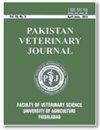Efficacy of Kaolin and Bentonite Clay to Reduce Aflatoxin M1 Content in Contaminated Milk and Effects on Milk Quality
IF 5.4
3区 农林科学
Q1 VETERINARY SCIENCES
引用次数: 12
Abstract
Received: Revised: Accepted: Published online: September 11, 2019 November 09, 2019 November 18, 2019 January 05, 2020 Mycotoxins contamination in milk products represents a major problem for milk industries. Aflatoxin M1 (AFM1) is very stable and resists any heat treatments as pasteurization and sterilization methods. The aim of this study was to determine the level of aflatoxin M1 in fifty raw milk samples collected from different dairy shops in Kafr El-Sheikh governorate in Egypt. We also evaluated the efficacy of detoxification methods of AFM1 in milk by using natural clay as Kaolin and Cabentonite. The milk survey study revealed that AFM1 was detected in all the examined raw milk samples with mean value of 10.7±0.89 ppb, which exceeded the Egyptian standard and European Union limit in raw milk. Then we artificially contaminated raw milk samples with AFM1 standard and then added three different concentrations of Kaolin and Cabentonite (5gm, 10gm, 20 gm), separately. The obtained results showed a significant reduction and detoxification in AFM1 concentration by Kaolin and Cabentonite treatments comparing with non-treated milk. The percent AFM1 detoxification rate by using kaolin and Cabentonite clay was 86.1 to 93.3% and 93.7 to 97.7%, respectively without any changes in nutritional constituents of milk. Moreover, the Ca-bentonite clay revealed a tendency to the comprehensive removal of AFM1 by increasing the quantity of clay added to the tested milk. These results indicate efficacy and safe usage of kaolin and Ca-bentonite clay to detoxification and reduce the amount of AFM1 in raw milk and consequently; minimize its dangerous effect on the public health. ©2019 PVJ. All rights reserved高岭土和膨润土降低污染牛奶中黄曲霉毒素M1含量的效果及对牛奶品质的影响
收到:修订:接受:在线发布:2019年9月11日2019年11月09日2019年11月18日2020年1月05日牛奶产品中的霉菌毒素污染是牛奶行业面临的主要问题。黄曲霉毒素M1 (AFM1)非常稳定,抵抗任何热处理,如巴氏灭菌和灭菌方法。本研究的目的是确定从埃及Kafr El-Sheikh省不同乳制品店收集的50份原料奶样品中黄曲霉毒素M1的水平。我们还评估了天然粘土如高岭土和膨润土对牛奶中AFM1解毒方法的效果。牛奶调查研究显示,在所有被检查的原料奶样品中检测到AFM1,平均值为10.7±0.89 ppb,超过了埃及标准和欧盟原料奶限量。然后用AFM1标准对原料奶样品进行人工污染,然后分别添加3种不同浓度的高岭土和膨润土(5gm, 10gm, 20gm)。结果表明,与未处理的牛奶相比,高岭土和膨润土处理显著降低和解毒AFM1浓度。在不改变牛奶营养成分的情况下,高岭土和膨润土对AFM1的解毒率分别为86.1 ~ 93.3%和93.7 ~ 97.7%。此外,钙基膨润土随着添加量的增加,有全面去除AFM1的趋势。这些结果表明,高岭土和钙基膨润土对解毒和减少原料奶中AFM1的量是有效和安全的。尽量减少其对公众健康的危险影响。©2019 PVJ。版权所有
本文章由计算机程序翻译,如有差异,请以英文原文为准。
求助全文
约1分钟内获得全文
求助全文
来源期刊

Pakistan Veterinary Journal
兽医-兽医学
CiteScore
4.20
自引率
13.00%
发文量
0
审稿时长
4-8 weeks
期刊介绍:
The Pakistan Veterinary Journal (Pak Vet J), a quarterly publication, is being published regularly since 1981 by the Faculty of Veterinary Science, University of Agriculture, Faisalabad, Pakistan. It publishes original research manuscripts and review articles on health and diseases of animals including its various aspects like pathology, microbiology, pharmacology, parasitology and its treatment. The “Pak Vet J” (www.pvj.com.pk) is included in Science Citation Index Expended and has got 1.217 impact factor in JCR 2017. Among Veterinary Science Journals of the world (136), “Pak Vet J” has been i) ranked at 75th position and ii) placed Q2 in Quartile in Category. The journal is read, abstracted and indexed internationally.
 求助内容:
求助内容: 应助结果提醒方式:
应助结果提醒方式:


